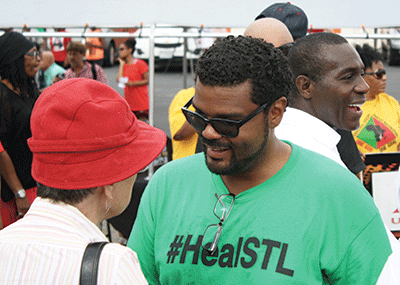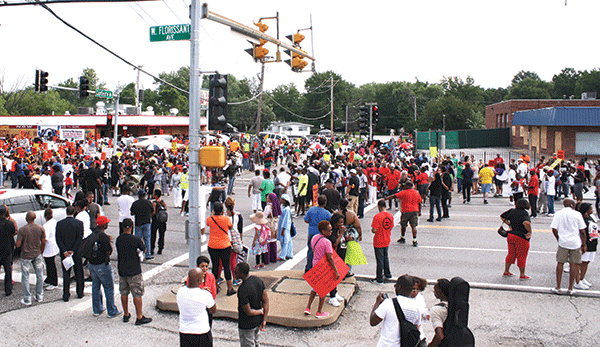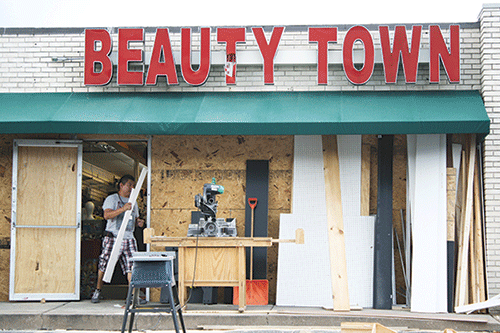
By Evan Sandel
The Scene staff
The shooting of an unarmed black teenager by a white police officer in Ferguson happened only 3 miles from St. Louis Community College at Florissant Valley, forcing officials to deal with the shock, sadness, anger and confusion of students.
College action ranged from organizing “listening circles” to bringing in a professional consultant to gather information and make recommendations on what to do next.
“The primary goal (of the listening circles) was to build trust,” said sociology professor LaRhonda Wilson, who helped coordinate them at Flo Valley. “We wanted our students to feel like they would be safe, and we knew that some of our students may want a safe place to empty out their heads and their hearts about what has been going on, and we wanted to give that to our students in a non-judgmental space.”
Ferguson made national news on Aug. 9, when Brown, 18, was shot and killed near Canfield Green apartments by Ferguson police officer Darren Wilson. Police, friends and witnesses have provided contradictory accounts of what happened.
The shooting triggered a week of riots and looting, which intensified after police used controversial methods of crowd control, including tear gas and military equipment.
School wasn’t in session at the time, but the chaos affected STLCC students throughout the district.
“Being the mother of a 4-year-old black male, I try to instill in him respect and all of those good values now,” said Forest Park nursing student Latosha Taylor, 29, who also is a science tutor.
“Because if this doesn’t change, then I have to worry about safety for my son.”
David J. Smith, the professional consultant hired by the college, has stressed the importance of preparing students and other local residents to deal with potential problems in the future.
“The whole event is not really done because the grand jury is still meeting (to decide whether to charge Wilson),” he said. “And there is the possibility when the grand jury comes back, possibly without an indictment, that that may cause more violence.”

TWO-PART APPROACH
Fall semester began Aug. 18 on STLCC campuses, and the college was ready to help its shaken students — particularly at Flo Valley — with a two-part plan of action.
The first step involved student-led listening circles. The idea was to allow students to share their feelings with an “objective audience” and build trust with faculty, staff and administrators.
“We want them to know that we serve a purpose on this campus academically, and that that includes the entire picture for their lives,” Wilson said. “Their personal experiences are interconnected with their academic experiences.”
The second step of the college’s plan was to hire Smith, an educational consultant based in Washington, D.C., who specializes in conflict resolution and peace-building.
“My role was to come out and listen, to generate ideas and conversation,” he said. “And after that’s done, to issue a report to the college, summarizing what I learned and issuing some recommendations.”
Smith began his investigation by meeting with small groups of students and faculty leaders to get their opinions on the Ferguson shooting and the circumstances leading up to it.
“The Michael Brown situation is a catalyst for the larger issues that are underlying,” Smith said. “Many students surveyed indicated that there was large-scale racism in the area.”
Wilson maintains that Brown attacked him after the police officer told the teenager to stop walking down the middle of the street, forcing Wilson to defend himself. Brown’s friend and other witnesses argue that Brown was a victim of racial profiling, and that he had his hands up when Wilson fired.
Taylor is one of many students who have recognized racial divisions on STLCC campuses. The Forest Park student body is about 55 percent black and 35 percent white.
“I believe that the students here kind of cling to their own kind,” Taylor said. “…We tend to segregate ourselves.”

WORKING FOR CHANGE
Several local politicians – including St. Louis aldermen Antonio French and Sharon Tyus and Missouri State Sen. Maria Chapelle-Nadal — have reached national prominence for criticizing the “institutional racism” they say led to Brown’s death, as well as the militarized police reaction.
Such efforts have resulted in the mounting of body cameras on some Ferguson police officers. In addition, the city is considering the elimination of allegedly racist “poverty penalties,” including a $25 fee for vehicle towing and warrants for failure to appear in court.
Despite what some people see as progress, Smith suggests that more fundamental changes may be needed.
“Don’t confuse symbolism with action, and don’t assume that because there’s symbolism that there will be action that follows from that,” he said. “… Symbolism makes people feel good, and it may raise expectations, but if nothing follows from symbolism, then often you’re in a worse situation than you started from.”
STLCC students have several options for getting involved and taking positive action in the community.
“Langston Hughes, Martin Luther King Jr., W.E.B. Dubois — these leaders suggest that if you want your position to be known, if you want to look like a leader, if you want to be heard, you have to give to your community,” Wilson said. “You have to be civically engaged. If you’re not civically engaged, your complaints essentially fall on deaf ears.”
One thing students can do is vote. Black voter turnout was only 6 percent in Ferguson’s municipal election last year (17 percent for whites). The electorate was 52 percent white in a city where the population is 67 percent black.
Smith warns that problems can develop when residents don’t feel they are represented by city leaders.
“The mayor and city council of Ferguson have only been elected by about 15 percent of the population, right?” he asked. “Then most people in the city of Ferguson take no role in who the chief is and what the chief does. … If people are displeased with, for instance, the racial makeup of the police force, they should hold the chief of police accountable. … But you have to vote in order to play a role in that.”
STLCC students also can get involved in the campus community. Forest Park has nearly 20 organizations, including a Student Government Association and Human Services Club.
This semester, Flo Valley merged its Social Justice Club and Criminal Justice Club into the See Justice Club. Wilson serves as adviser.
“We helped with a concert that was intended to support the Ferguson Youth Initiative, called FYI, which has a recreation center and offers mentorship and tutoring programs to Ferguson youth,” she said.
The FYI is always in need of youth advocates, and organizers prefer college-age people because they can more easily relate to at-risk youth. A major goal of the initiative is to keep non-violent juvenile offenders out of detention centers. Advocates earn $25 an hour by mentoring.
Wilson also recommends that STLCC students engage in “service learning,” which is a way to earn college credit for community service, often as part of an honors project.
French oversees a youth mentorship and tutoring program called North Campus, which focuses on at-risk students in third through eighth grades. He recently founded #HealStl, a volunteer organization aimed at healing wounds resulting from the Brown shooting and registering Ferguson residents to vote.
Smith expects to release his STLCC report this fall. Some of his recommendations will involve educating the student body.
“When people are angry or upset, they need to know the appropriate means for articulating that,” he said. “Young people today, including college students, don’t necessarily understand non-violent approaches to responding. You want a situation where you’re not throwing bricks.”
